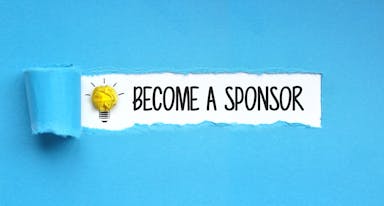Welcome
As we continue our European Vacation this week we arrive in Berlin, Germany.
One of the World’s major cities, it has an incredible (and often colourful) history, which we will explore a little in this issue.
We were there for New Years which made it tricky with some things being closed due to the holidays.
It is one of those cities that you should probably visit at least once!
Hope you enjoy Traveling Through History with me this week.
Michelle
Savvy Travel Historian
Monthly Theme - European Vacation
Berlin, Germany

Background
The largest city in Germany, not only by population (3.8 million) but also by area, Berlin’s settlement history dates back to 60,000 BC but is perhaps best known today for being the German capital, the Berlin Wall and its role in the end of the cold war.
Located in the northeast of Germany, Berlin can be easily reached by road on the many autobahns that approach it, as well as by train and all major airlines have daily flights to the Berlin Brandenburg Airport.

History
The city of Berlin has a long history of being at the forefront of German civilisation.
The earliest known settlement history dates back to 60,000 BC, with dense human settlement along Berlin’s river, the Spree from 2,000 BC.
The earliest written record is around the late 12thC. Historians consider 1237 as the founding date of the city.
Berlin was devastated during the Thirty-Years War from 1618-1648. Half the population died and around a third of the buildings were damaged or destroyed.
Napoleon marched into Berlin in 1806, but allowed it to remain self-governing.
Berlin grew to become the heart of the Kingdom of Prussia, the German Empire, and the Weimar Republic.

The 19th century saw Berlin at the forefront of industrialisation in Germany. The city became a major centre of politics, science, and the arts. The establishment of the German Empire in 1871, with Berlin as its capital, heralded a period of unprecedented growth and development.

Albert Einstein lived for a number of years in Berlin and rose to prominence during his time there, later being awarded the Nobel Prize for Physics in 1921.
Adolf Hitler came to power in 1933 and Berlin hosted the Summer Olympics in 1936 and this image of the rise of him and the Nazis was a sign of things to come.
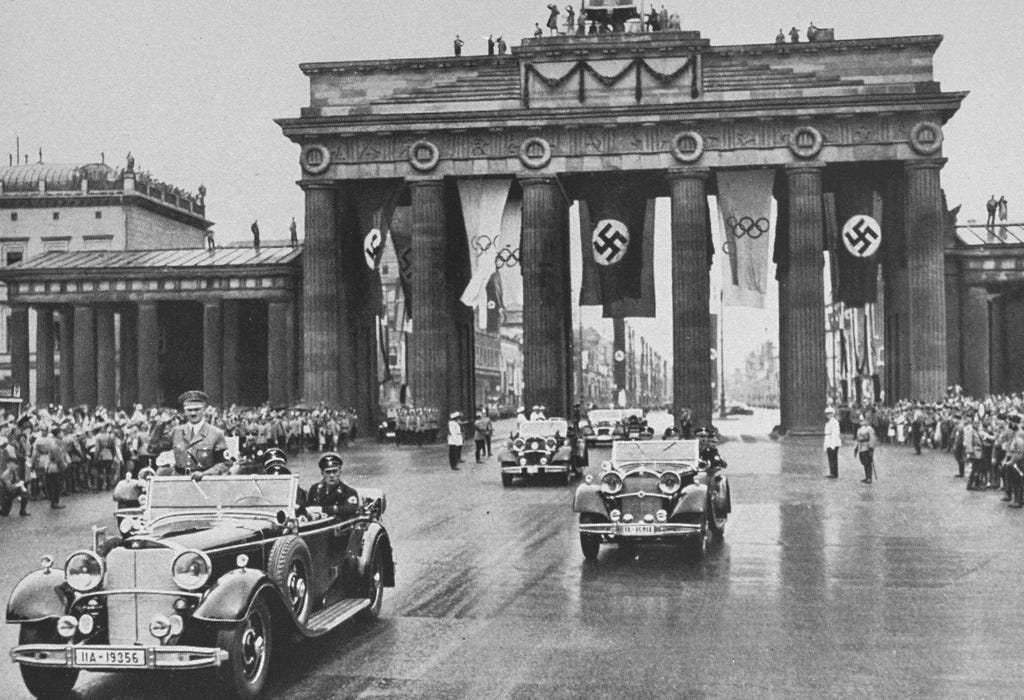
After the end of WWII and the dividing of Berlin, the capital of Germany moved to Bonn and was not reinstated until a vote by the Bundestag (German Parliament) in 1991. Under the Chancellorship of Gerhard Schrüder, this process was completed in 1999.
The Cold War
The Cold War era saw Berlin split into East and West, symbolised by the Berlin Wall, which stood from 1961 until 1989.
Checkpoint Charlie
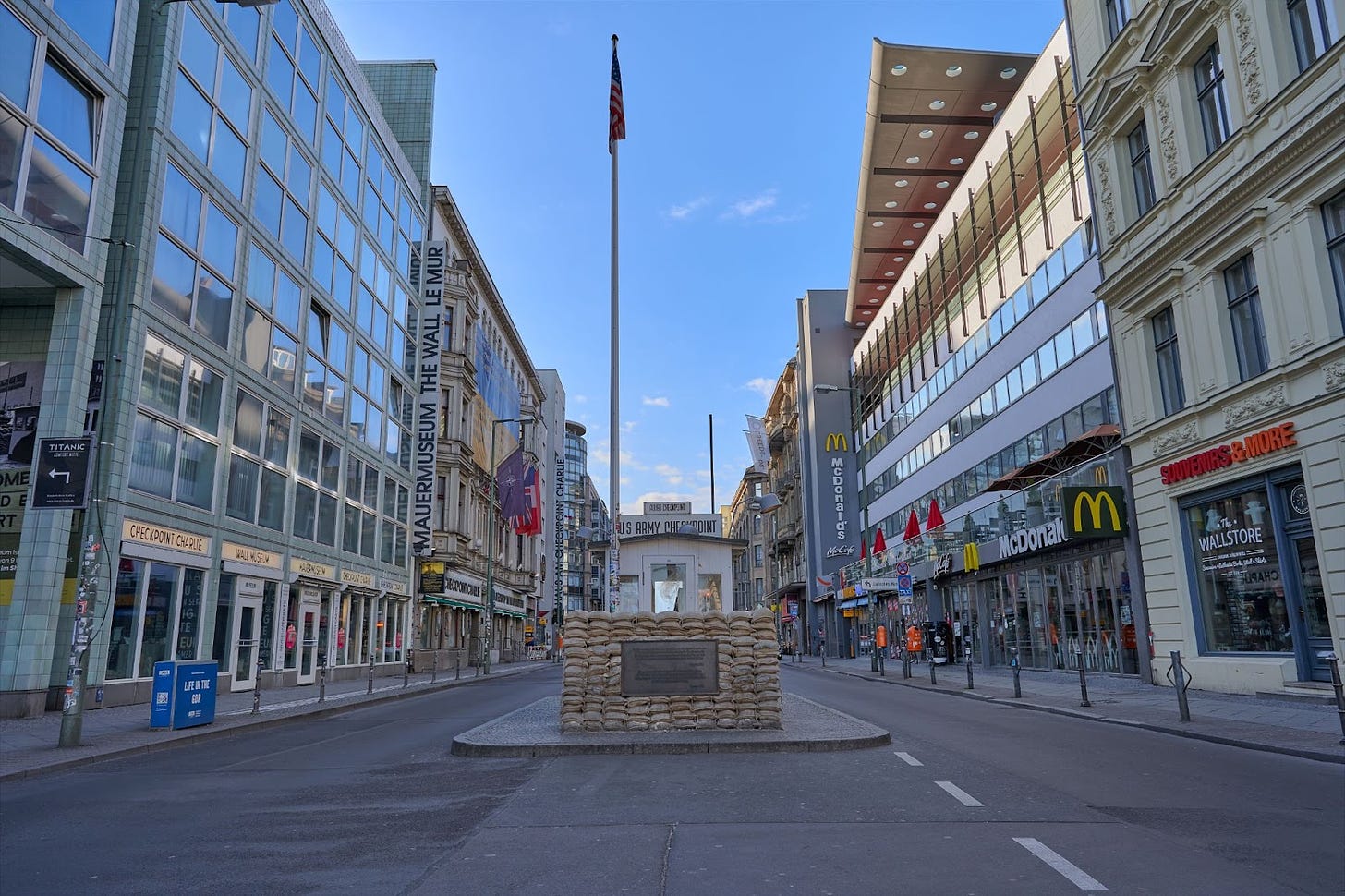
Featured in numerous famous movies (including Octopussy, The Spy who came in from the Cold, and The Man from U.N.C.L.E), Checkpoint Charlie, named by the Americans during the Allied occupation of the city, has become a favourite tourist photo opportunity (shown above).
It was the main crossing point between East and West Berlin, established after the division of the city following the end of WWII. After external borders were closed, Checkpoint Charlie was a point where Germans and international visitors were able to move relatively easily through both halfs. The crossing became the easiest way for East Germans to defect to the West resulting in a ‘brain drain’ of over three million East Germans (20% of the population) to the West from 1949-1961.
Walter Urbright, the East German leader, wanted to stop emigration and defection from the East to the West, a large proportion of which happened through the Berlin crossings. In the first seven months of 1961, 207,000 people defected. The East German economy suffered due to this drain of talent, mostly of young people.
At midnight on August 12/13, 1961 a temporary barbed-wire barrier was erected between East and West Berlin, a precursor to the permanent wall that would eventually be constructed.
The four powers governing Berlin included America, France, the United Kingdom and the Soviet Union. It was agreed that military personnel could freely move around Berlin without being stopped (while normal citizens faced some restriction). The ‘Berlin Crisis of 1961’ began because the US Chef de Mission in West Berlin, E. Allan Lightner, was stopped at Checkpoint Charlie on October 22, on his way to the opera in East Berlin that evening.
Over the coming days tensions were heightened and on October 27, ten Soviet tanks were driven to the border crossing at Checkpoint Charlie, subsequently joined on the other side by American tanks, facing off across the border divide (image below).
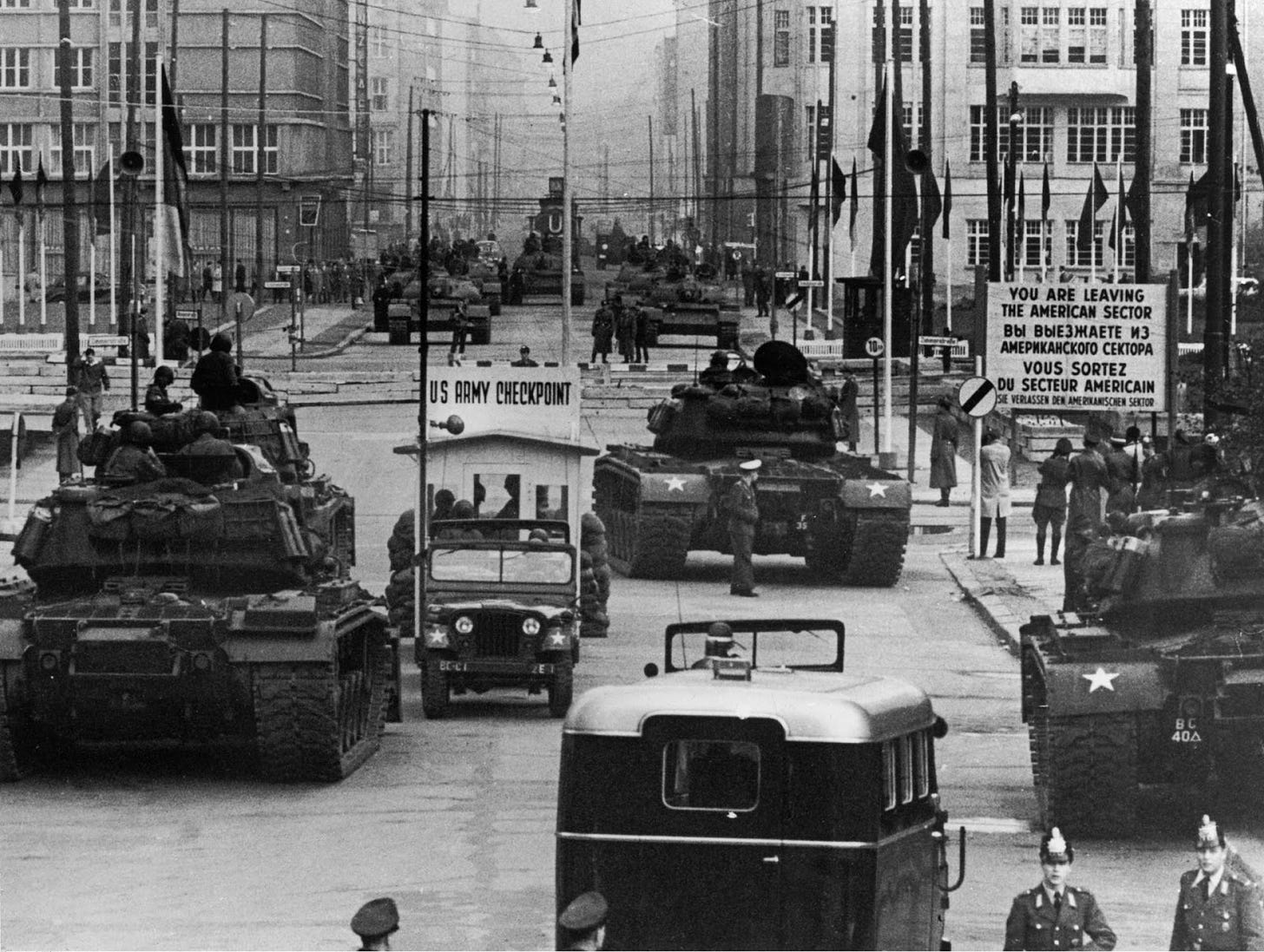
An agreement between President Kennedy in the White House and Khrushchev in the Kremlin saw each side's tanks move backwards, starting with the Soviets moving 5 metres, followed by the American’s. Kennedy commented that while a ‘wall’ was not a good solution, it was better than a war.
The original guardhouse booth on the American side remained until June 1990 and is now displayed in the Allied Museum.
The memorial guardhouse and sign there now, are based on the original structures built.
Berlin Wall
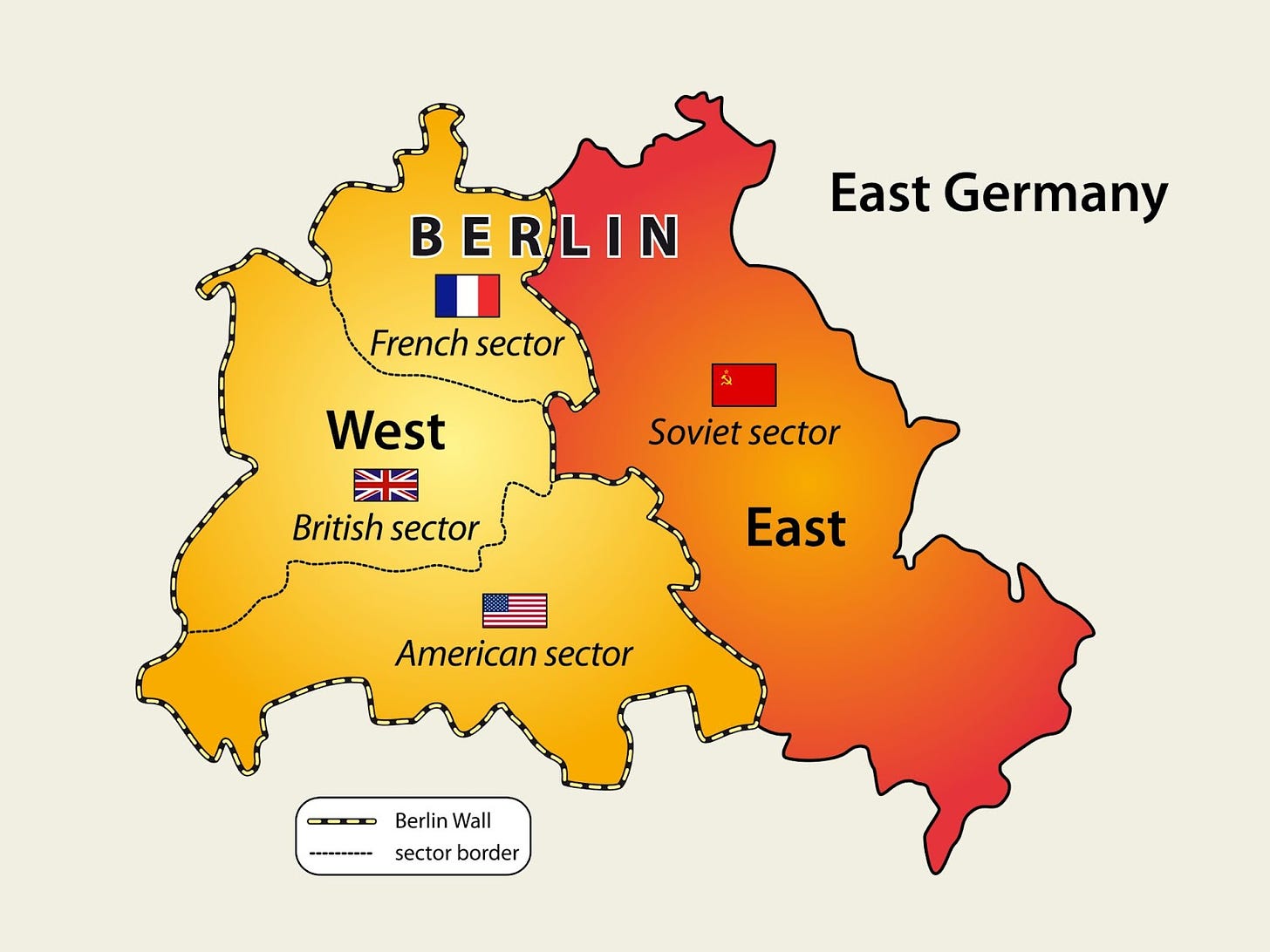
As previously mentioned, at midnight on August 12/13, 1961, East German military personnel began the construction of a barrier between East and West Berlin, to stop East Germans from defecting to the West.
The above image shows the division of Berlin after WWII and the outline of the Wall’s boundary. The wall was 140kms in length.
The Wall was constructed inside the East zone, so as not to encroach on Western territory. There was a guard tower every 600m.

In June 1962 an inner wall was added. This ‘dead zone’ was created with two sections of wall and a clearing zone between them. This enabled border guards to get a better view of people trying to escape. Based on geography there were different widths in different sections.

Over 100,000 people attempted to escape from East Germany during the period the wall was erected. Around 5,000 of them succeeded, with a death toll of around 200, although these numbers are disputed by both sides.
The Wall fell on 9 November 1989 after several weeks of civil unrest, spurred on by the fall of several of the Eastern Bloc regimes in surrounding countries. East German officials announced that GDR citizens could again visit Germany and West Berlin.
Crowds gathered on both sides of the wall and began dismantling it.
The official demolition of the Wall began on June 13, 1990 and was completed in 1994.
East Side Gallery
While most sections of the Wall were dismantled after reunification, a few areas remain including what is now known as the ‘East Side Gallery’.

Artists were invited to come and paint sections of the wall and these are photographed a lot by tourists.

There has been great debate amongst the people of Berlin and urban planners and developers about what to do with sections of land that, if used for housing and retail development, would be a profitable venture.
There are arguments for both sides. Those who want to make sure that the wall and what happened is never forgotten and those who believe the city needs to move on and provide money making opportunities for businesses to help Berlin grow.

As can be seen from the above image, in some areas apartments have been built right up to the wall fragments.
Museums
There are a number of museums in Berlin to visit. Too many to preview in this issue, but information on the different ones can be found here:
https://www.visitberlin.de/en/tickets-museum-exhibitions-berlin
DDR Museum
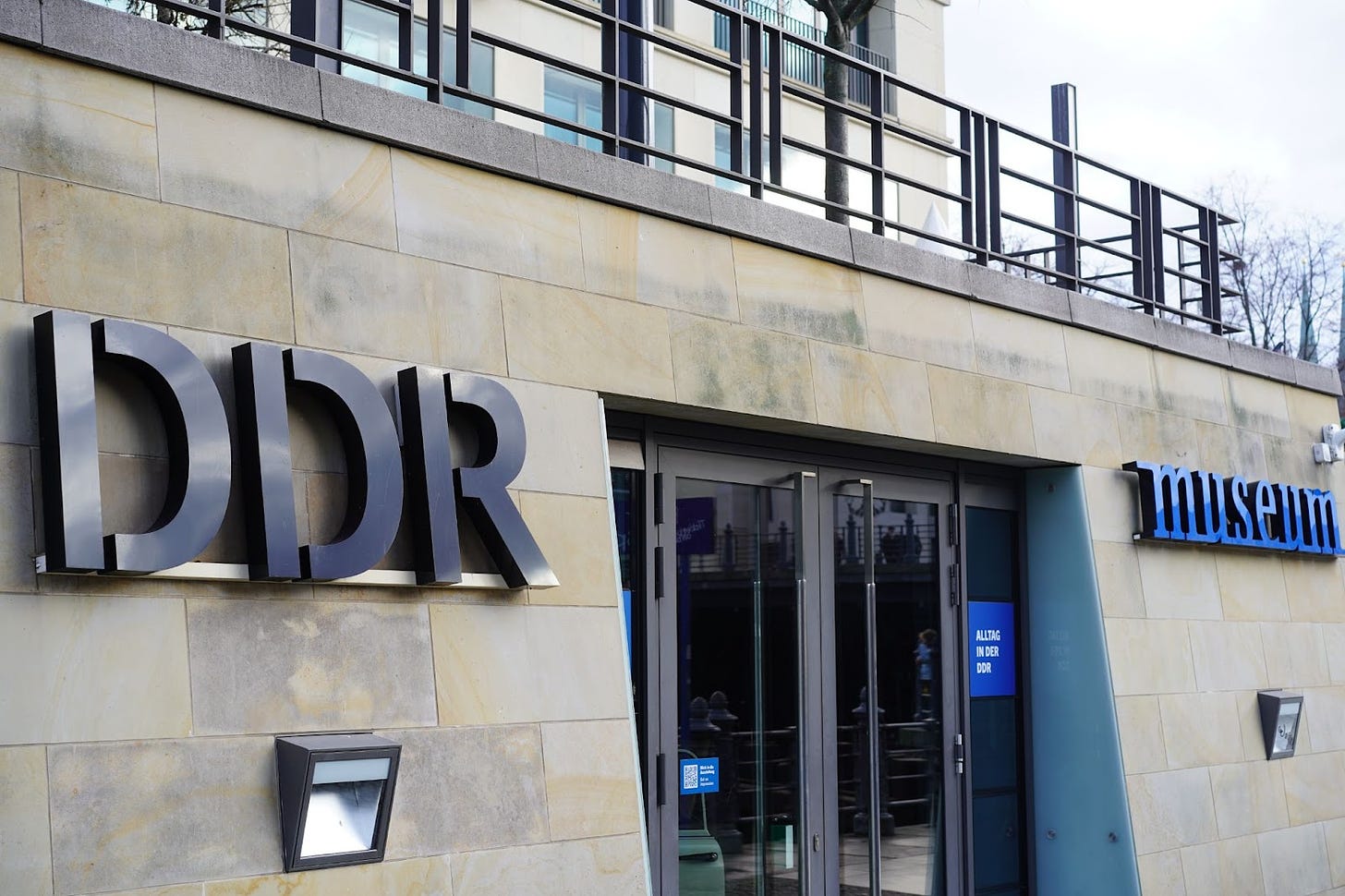
The DDR Museum is a collection of interactive and ‘hands on’ displays documenting life in the former GDR (German Democratic Republic). It has three main themes. Public Life, State and Ideology and Life in a Tower Block, which allows you to go inside a flat where East Germans lived.
With over 300,000 different objects in its collection, it is worth visiting to see what it was like to live in a state cut off from the outside World.
Information on visiting can be found here:
Memorial to the Murdered Jews of Europe & Museum

Located not far from the Führerbunker, the Memorial to the Murdered Jews of Europe is a haunting, reflective space in the historical district of Berlin.
Designed by architects Peter Eisenman and Buro Happold, the above ground memorial of 19,000 sqm, has 2,711 concrete slabs, placed in a grid pattern to represent all those killed. It was opened in 2005, sixty years after WWII ended.
An underground information centre, records the names of the three millions Jewish Holocaust victims and some of their stories.
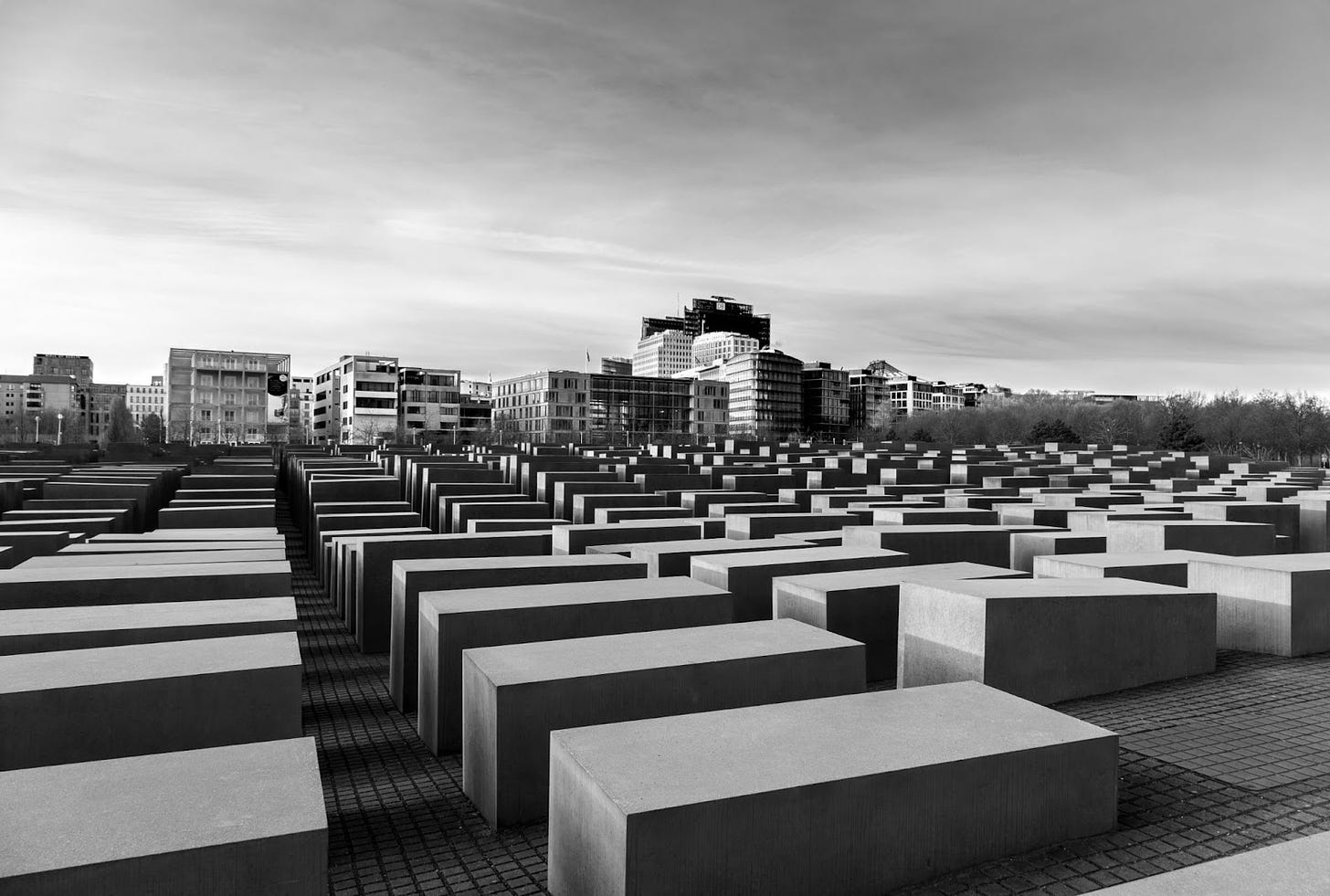
While it is definitely worth seeing, the information conveyed in the museum is haunting and confronting and some people may find it distressing. A timeline documents what happened and when, and the consequences for the Jewish people.

One of the things I found most distressing were the letters and postcards people sent to relatives elsewhere, indicating they knew what was coming, which certainly was the case as the war progressed. After a while I had to stop reading as it became overwhelming to continue. It is one of those places you go, where everybody there is very quiet as they progress through the exhibits. I am thankful I was able to go and see it but it was also very sad and moving.
Further Information can be found here:
Computerspielemuseum - Computer Games Museum

The first ever computer games museum can be found in Berlin. Six decades of gaming history can be found here and it was certainly a trip back in time for us and our boys.

Almost every console in existence can be found here, with many of them still playable.

It’s a very hands-on user experience, which doesn’t only extend to hardware. An interactive wall of computer games, can be searched to discover fun facts about your favourite games, whether old or new.

It is inexpensive to visit, at only €11 per person. Details on visiting can be found here:
https://www.computerspielemuseum.de/en/43-Homepage.htm
Landmarks
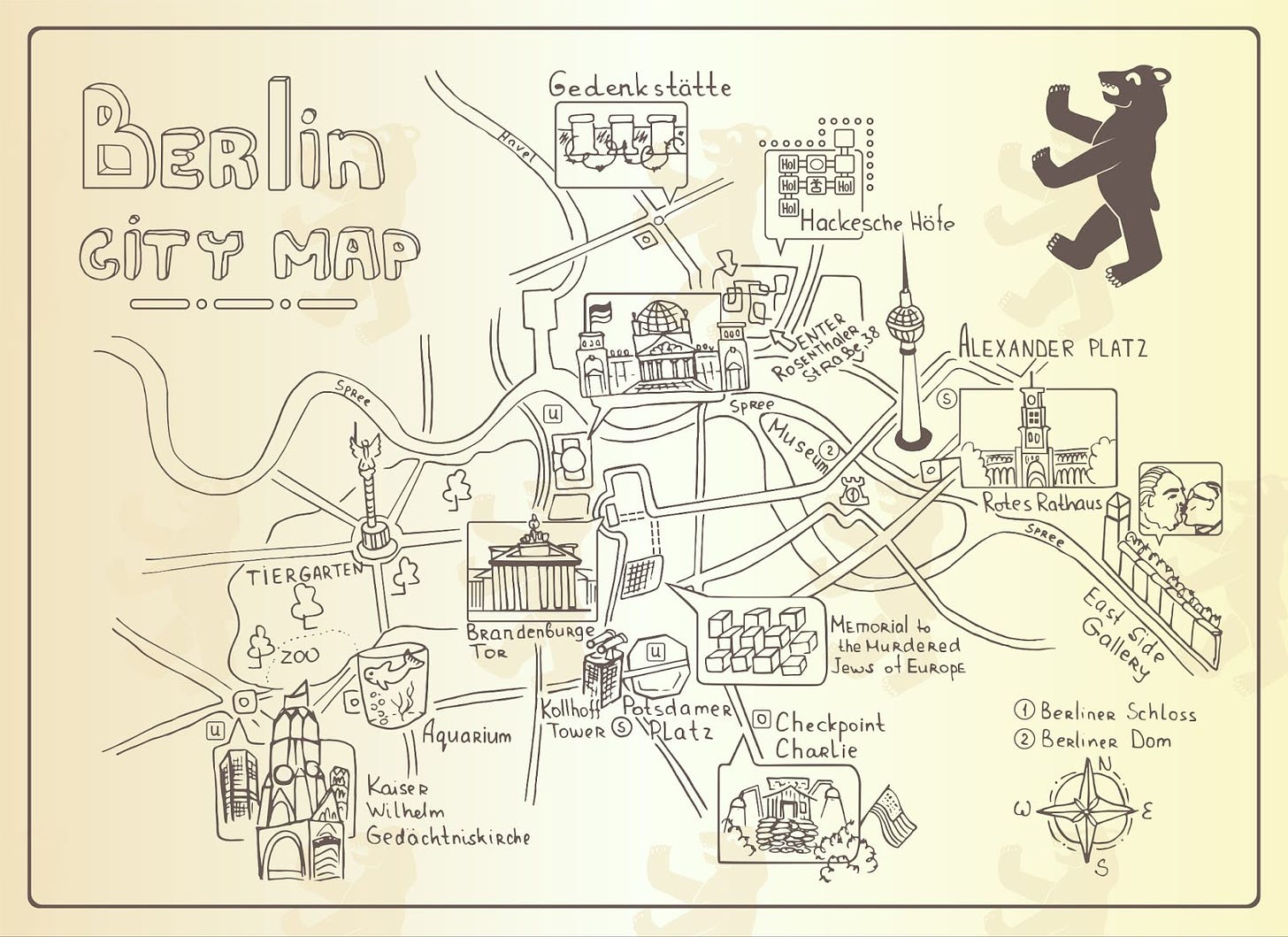
Brandenburg Gate

One of Berlin’s (and Germany’s) most famous landmarks is the Brandenburger Tor (Brandenburg Gate).
Built by Frederick William II, King of Prussia in the 18thC (1788-1791), it used to be the city gate site, marking the road from Berlin to the then capital Margraviate of Brandenberg. It stands at 26m high and 65.5m long.

It is located on the newly redeveloped Pariser Platz and is located in the western part of the city.
The neo-classical monument draws parallels with a Roman triumphal arch but was one of the first Greek revival architectural pieces in Germany.
The ‘quadriga’ on the top, features four horses pulling a chariot and was added in 1793.
Napoleon was the first ruler to use the gate in a triumphal procession in 1806 and took the quadriga to Paris as war booty and a sign of his victory over the city. It was returned in 1814 after he abdicated.
While cars used to be able to drive under it after the city’s reunification in the 1990s, it has now been turned into a pedestrian only zone.
When the gate was officially open in the unified city on December 22, 1989, 100,000 people gathered at it to celebrate.
Victory Column

The Victory Column was originally located near Köingsplatz but was relocated by the Nazis’ to its current location at the end of Tiergarten, in an area known as the Great Star, due to the intersecting roads in this location.
Designed after the Second Schleswig War in 1864 to commemorate the Prussian victory, its purpose was reinforced when inaugurated in September 1873, because by then victories had been achieved in two other wars (Austro-Prussian War and the Franco-Prussian War).
Because of this, the winged statue of Victoria, the Roman goddess of Victory was added which made the column 67m tall.
Hauptbahnhof

Berlin’s main railway station was opened in 2006. It is huge inside, with two platform levels and an additional three levels for retail and businesses.

Reichstag

The Reichstag is the home of the German Parliament. The building was started in 1884 and completed ten years later. From 1919-1933, it was the seat of government for the Weimar Republic.
Shortly after Hilter came to power in 1933, an arson attack gutted most of the building and it lay in ruins for the following 12 years of Nazi rule.
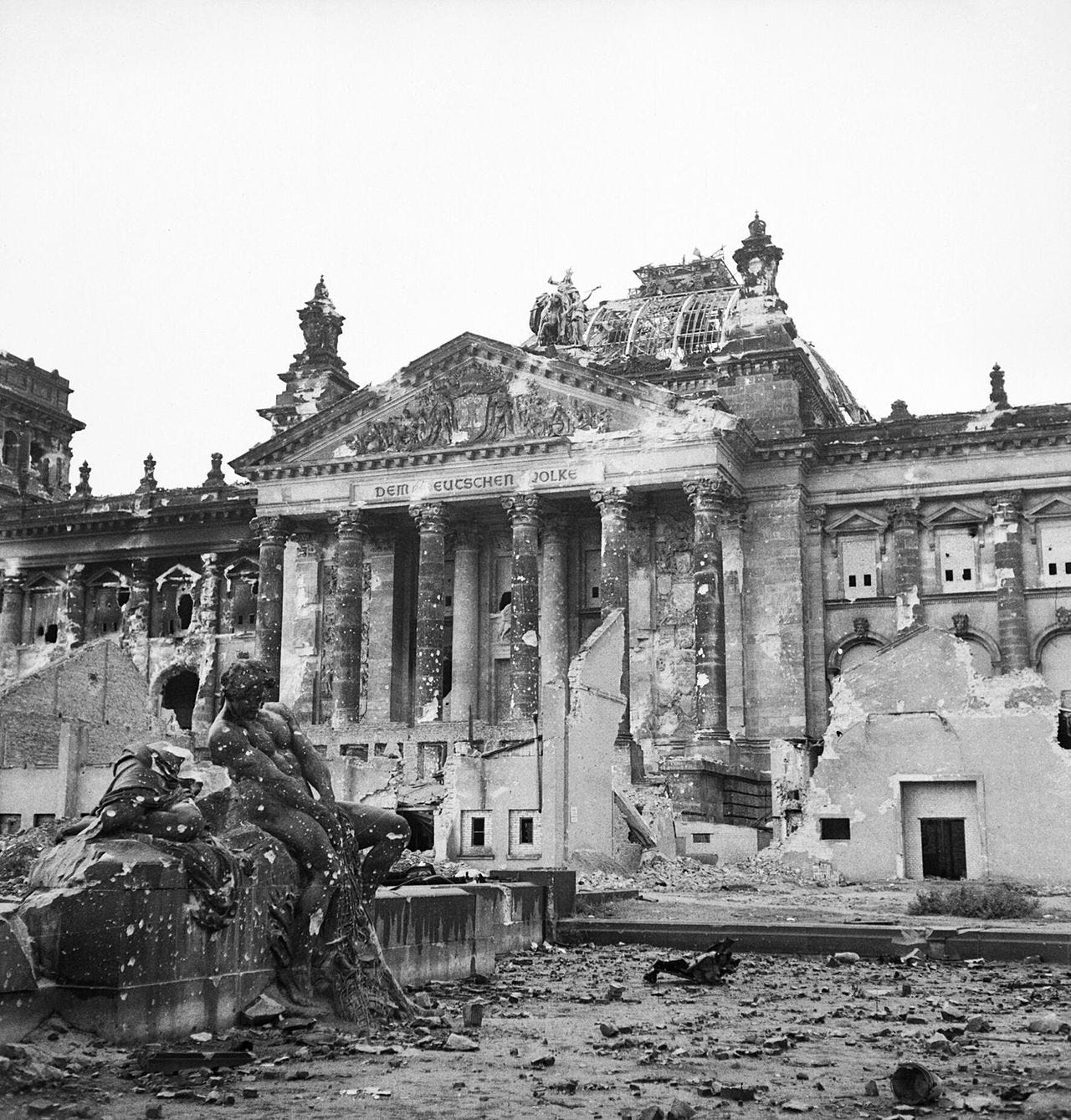
When the Red Army arrived in Berlin, the building was a strategic capture but uninhabitable (see image above).
The Reichstag was in West Berlin during the period the wall was erected and in 1956 it was decided to restore the building rather than demolish it. Reconstruction started in 1961 and was completed in 1971.
Under the provision of the ‘Four Power Agreement on Berlin’ the West German government was not allowed to assemble in the building so it was only used for one off events and concerts.
The official reunification ceremony was held there on October 3, 1990 but as Berlin was not yet the capital again, aside from an historic meeting of Parliament in the building by way of celebration, nothing was held there until after reconstruction to make it the seat of the German Government in 1999.
A huge glass dome was erected on the roof, as a throwback to the original cupola that was on the building.
Prior registration is required to go inside the building and climb the dome. You will need photo ID when purchasing your tickets.
Follow this link for further information:
https://www.bundestag.de/en/visittheBundestag/dome/registration-245686
Traveling Through History is a reader-supported publication. To receive new posts and support my work, consider becoming a free or paid subscriber.
The Führerbunker - Hilter’s Bunker

The Führerbunker, located near the ‘Reich Chancellery’ (the old office of the German Chancellor) on Gertrud-Kolmar Strasse, is best known for being the place where Hiler and Eva Braun committed suicide after the Battle of Berlin and the fall of the Third Reich during WWII.

Constructed 8.5m (28 ft) underground, the 30 rooms were protected by 4m (9ft 10in) of concrete. Despite being self-contained, because it was below the water table, it was damp and required pumps to constantly run to remove excess ground water making conditions unpleasant.
Hilter moved into the bunker in January 1945, joined in April by Eva and Goebbels (and his family). He had two-three dozen support staff with him.
The Russian ‘Red Army’ surrounded Berlin on April 16, which started the ‘Battle of Berlin’. The last time Hilter went outside on the surface was on April 20, his 56th birthday.
It was not until April 22nd that Hilter realised that the war was lost, and despite all his efforts to command his generals and troops to attack from the north and north-east, it was futile.
On April 28-29 at around midnight Hilter married Eva in the bunker and wrote his last will and testament, appointing the Head of Government and Chancellor position to Goebbels upon his death (Goebbels was to hold the position for one day before committing suicide himself).
On the afternoon of April 30th, Hilter shot himself in the bunker, with Eva taking cyanide. As per his instructions, their bodies were burned in the garden of the Reich Chancellery.
On the 2nd of May the Russian Army entered the Chancellery and bunker.
The bunker was blown up in December of 1947 and all subsequent buildings leveled by the Soviets who wanted to erase any trace of the Third Reich. No one wanted the area to become a shrine.
Today the exit from the Führerbunker and the gardens of the Reich Chancellery are a carpark. [Fun Fact: our hire car was parked there during our stay - white car on the right!]

We were in Berlin for New Years Eve. Not the safest time to be there after the NYE riots in 2022.

However we all went to the party at the Brandenburg Gate and made it back to our hotel, through some tricky areas and after passing barricades by the Police to get into the area we were staying.

It was cordoned off from the rest of the City as many of the Embassies were housed there.

While not expecting it to be like Sydney for NY, the fireworks were a bit disappointing but we still enjoyed being out and about with people.

If you’d like to dive further into visiting Berlin, this is the official Government website:
https://www.berlin.de/en/tourism/

Michelle is a speaker, author, content marketer, historian and mother of 3 boys.
After 25 years in business and as the ‘Content Marketing Queen’ for the past 12 years, she has helped countless small businesses understand and develop their content strategies and focus on a customer first approach.
Savvy Travel Historian is her passion project, and her weekly newsletter is available on Substack, Paragraph and Mirror. The latter two allows you to collect each Issue as an NFT.
Michelle is co-host of the Business on the Bloc podcast, a weekly show which talks about the digital media revolution and how it applies to B2B marketing, sales and operations. The show is recorded live every Wednesday at 4pm EST/ 9pm UTC on LinkedIn, YouTube & Bolt+.
You can follow Michelle in these places:
Savvy Travel Historian Instagram
Content Marketing Queen Website
*Please Note: I use AI tools to assist with research, images and sometimes with small sections of text.
